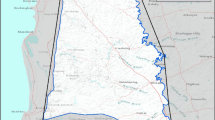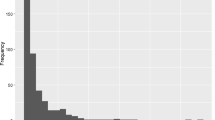Abstract
The subject of this paper is the possibility of using self-organizing map (SOM) in the biomonitoring studies. We used lichens as biomonitors to indicate different degrees of air quality. This research included all of 88 lichen species that was collected at 75 investigated points. These lichen species showed the different responses to air pollution. The air quality was assessed by IAP (index of atmospheric pollution) values. The IAP values were calculated for all of investigated points on the territory of four natural and one urban ecosystem. Calculated IAP values were in range of 10 to 75. On the basis of the lichen data and IAP values, we have employed SOM analysis that distinguished three clusters (A, B, and C). It presented lichen indicator species for each cluster: 16 species for cluster A, 18 species for cluster B, and two species for cluster C. This paper presents a useful method to find indicator species.



Similar content being viewed by others
References
Boamponsem, L. K., & de Freitas, C. R. (2017). Validation of Parmotrema reticulatum as a biomonitor of elemental air pollutants in Auckland, New Zealand. Journal of the Royal Society of New Zealand, 47, 275–293.
Byazrov, L. G. (2002). Lichens in ecological monitoring. Moscow: Scientific World.
Chaparro, M., Lavornia, J. M., Chaparrro, M., & Sinito, A. (2013). Biomonitors of urban air pollution: magnetic studies and SEM observations of corticolous foliose and microfoliose lichens and their suitability for magnetic monitoring. Environmental Pollution, 172, 61–69.
Chon, T. S. (2011). Self-Organizing Maps applied to ecological sciences. Ecological Informatics, 6, 50–61.
Chon, T. S., Park, Y. S., Moon, K. H., & Cha, E. Y. (1996). Patternizing communities by using an artificial neural network. Ecological Modelling, 90(1), 69–78.
Chon, T. S., Park, Y. S., & Park, J. H. (2000). Determining temporal pattern of community dynamics by using unsupervised learning algorithms. Ecological Modelling, 132(1), 151–166.
Conti, M. E., & Cecchetti, G. (2001). Biological monitoring: lichens as bioindicators of air pollution assessment—a review. Environmental Pollutions, 114, 471–492.
Davies, L., Bates, J. W., Bell, J. N. B., James, P. W., & Purvis, O. W. (2007). Diversity and sensitivity of epiphytes to oxides of nitrogen in London. Environmental Pollution, 146, 299–310.
Deljanin, I., Antanasijević, D., Vuković, G., Aničić-Urošević, M., Tomašević, M., Perić-Grujić, A., et al. (2015). Lead spatio-temporal pattern identification in urban microenvironments using moss bags and the Kohonen self-organizing maps. Atmospheric Environment, 117, 180–186.
Dobson, F. S. (2005). Lichens. Richmond: Richmond Publishing Co. Ltd..
Dufrêne, M., & Legendre, P. (1997). Species assemblages and indicator species: the need for a flexible asymmetrical approach. Ecological Monographs, 67, 345–366.
Hawksworth, D. L., & Rose, F. (1970). Qualitative scale for estimating sulphur dioxide air pollution in England and Wales using epiphytic lichens. Nature, 227, 145–148.
Jain, A. K., & Dubes, R. C. (1988). Algorithms for clustering data. New Jersey: Prentice-Hall.
Josifović, M., (Ed.), 1970-1976. Flora SR Srbije 1-8. Srpska akademija nauka i umetnosti, Beograd.
Josifović, M. (Ed.). (1977). Flora SR Srbije 9, dodatak. Beograd: Srpska akademija nauka i umetnosti.
Kodnik, D., Winkler, A., Candotto Carniel, F., & Tretiach, M. (2017). Biomagnetic monitoring and element content of lichen transplants in a mixed land use area of NE Italy. Science of the Total Environment, 595, 858–867.
Kohonen, T. (2001). Self-organizing maps. Berlin: Springer.
Kricke, R., & Loppi, S. (2002). Bioindication: The I.A.P. Approach. In P. L. Nimis, C. Scheidegger, & P. Wolseley (Eds.), Monitoring with Lichens — Monitoring Lichens (pp. 21-37). Kluwer academic Publishers.
Kruk, A., Lek, S., Park, Y. S., & Penczak, T. (2007). Fish assemblages in the large lowland Narew River system (Poland): application of the self-organizing map algorithm. Ecological Modelling, 203, 45–61.
Llop, E., Pinho, P., Matos, P., Pereira, M. J., & Branquinho, C. (2012). The use of lichen functional groups as indicators of air quality in a Mediterranean urban environment. Ecological indicators, 13, 215–221.
Loppi, S., & Corsini, A. (2003). Diversity of epiphytic lichens and metal contents of Parmelia caperata thalli as monitors of air pollution in the town of Pistoia (c Italy). Environmental Monitoring and Assessment, 86, 289–301.
Loppi, S., Ivanov, D., & Boccardi, R. (2002). Biodiversity of epiphytic lichens and air pollution in the town of Siena (central Italy). Environmental Pollution, 116, 123–128.
Lorenzini, G., Landi, U., Loppi, S., & Nali, C. (2003). Lichen distribution and bioindicator tobacco plants give discordant response: a case study from Italy. Environmental Monitoring and Assessment, 82, 243–264.
Marié, D. C., Chaparro, M. A. E., Lavornia, J. M., Sinito, A. M., Castañeda Miranda, A. G., Gargiulo, J. D., Chaparro, M. A. E., & Böhnel, H. N. (2018). Atmospheric pollution assessed by in situ measurement of magnetic susceptibility on lichens. Ecological Indicators, 95, 831–840.
Mayer, W., Pfefferkorn-Dellali, V., Tuerk, R., Dullinger, S., Mirtl, M., & Dirnboeck, T. (2013). Significant decrease in epiphytic lichen diversity in a remote area in the European Alps, Austria. Basic and Applied Ecology, 14, 396–403.
McCune, B., & Mefford, M. J. (1999). PC-ORD. Multivariate analysis of ecological data, Version 4. MjM Software Design, Gleneden Beach, Oregon.
Nimis, P. L., Castello, M., & Perotti, M. (1990). Lichens as biomonitors of sulfur dioxide pollution in La Spezia (Northern Italy). Lichenologist, 22, 333–344.
Nimis, P. L., Scheidegger, C., & Wolseley, P. (2002). Monitoring with Lichens-Monitoring Lichens. Kluwer academic Publishers.
Palmer, M. (1993). Putting things in even better order: the advantages of canonical correspondence analysis. Ecology, 74(8), 2215–2230.
Park, Y. S., Céréghino, R., Compin, A., & Lek, S. (2003). Applications of artificial neural networks for patterning and predicting aquatic insect species richness in running waters. Ecological Modelling, 160, 265–280.
Park, Y., Oberdorff, T., & Lek, S. (2005). Patterning riverine fish assemblages using an unsupervised neural network. In S. Lek, M. Scardi, P. Verdonschot, J. P. Descy, & Y. S. Park (Eds.), Modelling Community Structure in Fresh water Ecosystems (pp. 43–53). Berlin: Springer.
Park, Y. S., Grenouillet, G., Esperance, B., & Lek, S. (2006). Stream fish assemblages and basin land cover in a river network. Science of the Total Environment, 365, 140–153.
Penczak, T. (2007). Can velocity affect growth and fecundity of facultative riverine fish species? Polish Journal of Ecology, 55, 357–366.
Penczak, T., Kruk, A., Koszalinski, H., Kostrzewa, J., Marszal, L., Galicka, W., et al. (2000). Fishes of three oxbow lakes and their parent Pilica River: 25 years later. Polish Archives Hydrobiology, 47, 115–130.
Penczak, T., Godinho, F., & Agostinho, A. (2002). Verification of the dualism ordering method by the canonical correspondence analysis: fish community samples. Limnologica - Ecology and Management of Inland Waters, 32, 14–20.
Penczak, T., Kruk, A., Park, Y., & Lek, S. (2005). Patterning spatial variations in fish assemblage structures and diversity in the Pilica River system. In S. Lek, M. Scardi, P. Verdonschot, J. P. Descy, & Y. S. Park (Eds.), Modelling Community Structure in Freshwater Ecosystems (pp. 100–113). Berlin: Springer.
Perlmutter, G. B. (2010). Bioassessing air pollution effects with epiphytic lichens in Raleigh, North Carolina, USA. The Bryologist, 113, 39–50.
RHSS (2013). Republic Hydrometeorological Service of Serbia. Basic climate characteristics for the territory of Serbia. http://www.hidmet.gov.rs/podaci/meteorologija/eng/Klima_Srbije.pdf. Accessed 12 June 2020.
Saipunkaew, W., Wolseley, P. A., & Chimonoides, P. J. (2005). Epiphytic lichens as indicators of environmental health in the vicinity of Chiang Mai city, Thailand. Lichenologist, 37, 345–356.
Samecka-Cymerman, A., Stankiewicz, A., Kolon, K., & Kempers, A. J. (2009). Self-organizing feature map (neural networks) as a tool to select the best indicator of road traffic pollution (soil, leaves or bark of Robinia Pseudoacacia L.). Environmental Pollution, 157, 2061–2065.
Slaby, A., & Lisowska, M. (2012). Epiphytic lichen recolonization in the centre of Cracow (Southern Poland) as a result of air quality improvement. Polish Journal of Ecology, 60(2), 225–240.
SORS (2014). Statistical Office of the Republic of Serbia. Census of population, households and dwellings on the ethnicity of the population of the Republic of Serbia. https://publikacije.stat.gov.rs/G2014/PdfE/G20144012.pdf. Accessed 12 June 2020.
SORS (2016). Statistical Office of the Republic of Serbia. https://publikacije.stat.gov.rs/G2017/PdfE/G20171072.pdf. Accessed 12 June 2020.
Stojković, M., Simić, V., Milošević, D., Mančev, D., & Penczak, T. (2013). Visualization of fish community distribution patterns using the self-organizing map: a case study of the Great Morava River system (Serbia). Ecological Modelling, 248, 20–29.
Sujetovienė, G. (2015). Monitoring lichen as indicators of atmospheric quality. In D. K. Upreti, P. K. Divakar, & V. Shukla (Eds.), Recent advances in lichenology, modern methods and approaches in biomonitoring and bioprospection (pp. 87–118). New Delhi: Springer.
Van Dobben, H. F., & Ter Braak, J. F. (1999). Ranking of epiphytic lichen sensitivity to air pollution using survey data: a comparison of indicator scales. Lichenologist, 31, 27–39.
Van Haluwyn, C., & Van Herk, C. M. (2002). Bioindication: the community approach. In P. L. Nimis, C. Scheidegger, & P. A. Wolseley (Eds.), Monitoring with lichens—monitoring lichens (pp. 39–64). Dordrecht: Kluwer Academic.
Vesanto, J., Himberg, J., Alhoniemi, E., & Parhankangas, J. (2000). SOM toolbox for matlab 5. Technical Report A57. Neural Networks Research Centre, Helsinki University of Technology, Helsinki, Finland.
Washburn, S. J., & Cullen, T. M. (2006). Epiphytic macrolichens of the greater Cincinnati metropolitan area – part II: distribution, diversity and urban ecology. Bryologist, 109, 516–526.
Wielgolaski, F. E. (1975). Comparison of plant structure on grazed and ungrazed tundra meadows. Fennoscandian tundra ecosystems, 1, 86–93.
Will-Wolf, S., Jovan, S., Neitlich, P., Peck, J. E., & Rosentreter, R. (2015). Lichen-based indices to quantify responses to climate and air pollution across northeastern U.S.A. The Bryologist, 118(1), 59–82.
Wirth, V. (1995). Die Flechten Baden-Wurtembergs. Verbreitungsatlas, 1&2.
Acknowledgments
The authors would like to thank Professor Đurađ Milošević for help with the data analysis.
Funding
This research was supported by the Ministry of Education and Science of the Republic of Serbia, project OI 171025. The authors acknowledge the financial support from the Slovenian Research Agency (research core funding no. P1-0020).
Author information
Authors and Affiliations
Corresponding author
Additional information
Publisher’s note
Springer Nature remains neutral with regard to jurisdictional claims in published maps and institutional affiliations.
Electronic supplementary material
ESM 1
(DOC 2409 kb)
Rights and permissions
About this article
Cite this article
Ristić, S., Stamenković, S., Stojković Piperac, M. et al. Searching for lichen indicator species: the application of self-organizing maps in air quality assessment—a case study from Balkan area (Serbia). Environ Monit Assess 192, 693 (2020). https://doi.org/10.1007/s10661-020-08633-3
Received:
Accepted:
Published:
DOI: https://doi.org/10.1007/s10661-020-08633-3




